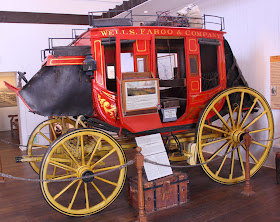As mentioned in past posts, the Stanislaus River played
a large role in the early California gold rush. Starting with the upper
branches of this river high in the Sierra-Nevada Mountains whose water was
diverted to towns like Columbia where the placer miners needed water to wash
the gold-bearing soil, clear down in the San Joaquin Valley where gold was
still found in the river. There miners searched for gold using hydraulic mining
and dredge mining.
Meanwhile, people gotta eat. Food and supplies were
moved up into the southern Mother Lode region, often called the Southern Mines,
by wagon and boat. Stockton, east of San Francisco and south of Sacramento,
served as a supply center.
However, the rivers, including the Stanislaus,
permitted boat travel only so far. At that point, cargo was shipped by wagon
where roads were possible, and by mules, where the terrain only allowed a path.
One of the many Stanislaus River crossings in this region that connected Calaveras and Tuolumne counties was
known as Parrott’s Ferry, now Parrott's Ferry Road or E18.
Thomas H. Parrott operated a ferry service beginning in 1860
to connect the mining towns of Tuttletown (Tuolumne County) and Vallecito
(Calaveras County). During the lake’s dry periods, sandbags laid in the river
created a dam that built up the lake level high enough so the ferry could float
across. The ferry had a wooden bottom and propelled across the lake by using
heavy cables anchored to a large boulder.
The ferry service lasted more than 40 years, until 1903 when
the first bridge over the river was built. After filling New Melones Reservoir,
the cables, boulder and sandbag remnants are no longer visible except in
drought years when the water of the New Melones Dam dips extremely low.
The Columbia-Vallecito bridge in use today opened in 1979.
The bridge is one of the tallest of its kind in the country. From the bluff
next to the bridge it is possible to see the New Melones Dam to the west.
For images of the original Parrott’s Ferry Bridge that came
to the surface during our recent drought, please CLICK HERE. To see
images of the current bridge that is one of the highest constructed, please CLICK
HERE.
No matter how many engineering wonders have been added to
crossing the Stanislaus River, now changed in nature from its original course
by several dams, this crossing retains the name of the pioneer who originally
helped make it possible for supplies and people to travel between the Pacific
Ocean and the gold mining regions in the mountains.
 |
| Parrott's Ferry (California Historical Landmark No. 438) |
Today there is a historical marker
to memorialize this location and it’s history. It is part of what is called the
Mark Twain- Bret Harte Trail. Both Bret Harte and Mark Twain wrote
stories set in this area during the Gold Rush. It reads:
Mark Twain Bret Harte Trail
Parrott's Ferry
Site of the ferry crossing established 1860 by Thomas H. Parrott connecting mining towns of Tuttletown and Vallecito. Ferry in operation until 1903 when first bridge built. Ferry boat of flat bottom wooden construction propelled on heavy cable. Cables ancherage in large boulder. Calavera side of bridge still visible 1949 at low water, sandbag dam built to form small lake.
My book, Millwright’s Daughter, mostly takes
place in a location just west of where Thomas Parrott operated his ferry. It is
part of the Under a Mulberry Moon anthology
which may be purchased by CLICKING HERE.
I am also finishing up a novel in The Widows of Wildcat Ridge series titled Nissa. It is currently on
pre-order and will be released on October 15th. To reach the book
description and purchase link, please CLICK HERE.
Here is a snippet, a little teaser from Nissa:
“We’ll turn and go back now.” Dallin
shifted a drowsy Molly to his other arm, moved to the outside of the boardwalk
and told Jamie to walk on the other side of his mother.
“Why’d we do that? Why didn’t we just
turn around where we were?”
“Because, Jamie, it’s polite for a
gentleman to walk on the outside of a walkway so a woman’s skirt doesn’t get
splashed by mud or dust if a wagon or horse travels too close to the
boardwalk.” Dallin leaned forward and smiled at Jamie. “I’m no expert on how to
be a gentleman, but my mother taught me that much.”
“I think you have done a fine job of
being a gentleman, Dallin. I appreciate your example and what you are teaching
my son.”
Nissa looked over to find Dallin’s gaze
locked on hers. They walked in that manner for several steps.
Nissa faced forward, fighting back
tears.
Why,
oh why could not James have been a father like this? Why couldn’t Dallin have
been Jamie’s father?
Sources for Parrott’s Ferry:
Images by ©2016 Robyn Echols, All
rights reserved.























